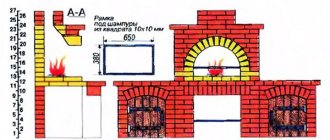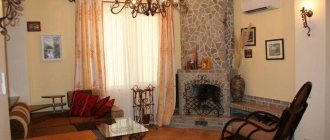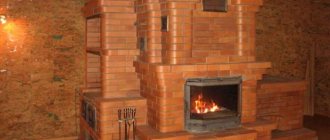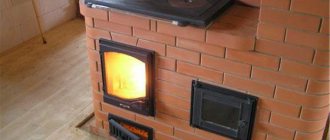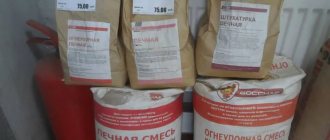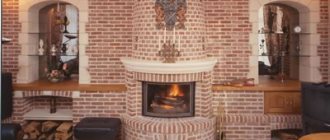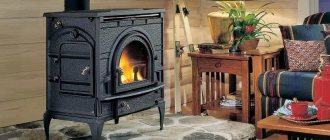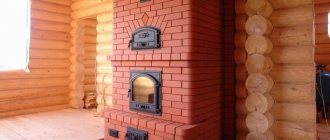Here you will learn:
- Classification of brick stoves
- Brick stove shapes for home
- Types of chimneys
- Structural elements of furnaces
- How to choose a stove for a brick house
- How to choose a place for the stove
- Features of laying a brick oven with your own hands
The history of the wood stove goes back centuries, if not millennia. In different countries, the best models have received well-deserved distribution.
Such designs are still used today, both in their classic form and with some additions.
Dutch
This design was created by Russian craftsmen. The design is not complicated and does not require much space. But this does not prevent it from giving off accumulated heat well.
Russian stove
Large-sized and multifunctional oven. But its size is justified by the presence of free space where you can relax. There is a firebox under the bed where you can cook food. Next to the firebox there is a stove, and just below there is a vent that keeps the fire going. There is also a niche for freshly prepared food.
A Russian stove can easily heat a room larger than 40 square meters. But a full-fledged robot will require a lot of raw materials.
Swede
Refer to compact options. Length and width - 1 meter . The main function is to heat the room, but you can also cook food on it. The unusual thing about such a stove is that the stove is built in the kitchen, and the rest of the stove will be in another part of the house.
This design is fire hazardous. But the risk of fire is reduced with the help of dampers.
Fireplaces and combined stoves-fireplaces
Furnace diagram
If we talk about fireplace stoves, then we immediately imagine some kind of brick building that serves as decoration for the apartment. However, a decorative fireplace and a fireplace stove are not the same thing. Considering devices associated with the word “fireplace”, we can distinguish the following varieties: decorative (artificial) fireplace, working fireplace and fireplace stove. An artificial hearth is a design element, and not a device for heating a living space. A real fireplace consists of a portal, firebox and chimney. Folding it won't be too difficult. Depending on the installation method, there are 3 main types:
- Corner fireplace . It is installed in the corner of the room. This arrangement allows you to heat several rooms at once.
- Closed fireplace . It takes up very little space as it is located in the wall of the house. The furnace is installed during the construction of the building.
- Open fireplace . Usually it is placed in the middle of the room in a large area. In this case, the chimney is suspended using special chain fastenings.
Brick fireplace stoves can have different shapes according to the chosen style. The classic version is a U-shaped design with decorative elements . D-shaped construction is typical for country style. The rectangular or semicircular hearth reflects the Art Nouveau style.
A fireplace stove is a kind of hybrid of a household stove and fireplace. The device quickly heats the room and is suitable for preparing any dishes, heating water and food, drying mushrooms and fruits. Masters of stove art offer a number of different designs that can be conveniently placed in a house of any layout (Fig. 6). In inclement weather, a brick stove-fireplace creates special comfort in the house.
Finnish stove
Finnish brick kilns got their name due to their fairly widespread use in Scandinavian countries. Their popularity in Russia is explained by the similarity of the climate and requirements for heating products. They belong to the bell type; the room is heated by heat transfer from the massive body of the stove.
The advantages of this type include:
- The ease of the device of this design;
- Light weight;
- The cost of such a model is quite budget-friendly;
- It has good heat transfer, traction and high efficiency;
- Due to the presence of a large firebox, it heats up quickly;
- A correctly folded structure is very aesthetically pleasing.
Brick oven "finka"
Drawing of a Finnish stove
The Finnish stove has a very large combustion chamber
Typically, such products are installed in the center of the room.
Classification of brick stoves
From the very name heating stoves, it becomes clear that these stoves are designed for heating premises, both residential and non-residential (garage, hangar, greenhouse, etc.).
– How are brick kilns constructed? – What types of brick kilns are there? – What are direct-flow or bell-type furnaces? What is the difference?
In this article we will consider options for heating stoves made of brick. The variety of such stoves is great and they differ primarily in the internal structure of the smoke channels.
Oven with horizontal channels
Oven with horizontal channels
In such a system, a cleaning door must be installed on each horizontal channel to remove ash and soot that settles on the horizontal surface of the channels. In such a stove, hot gases do not linger in the stove itself, but give off heat only as they move towards the chimney.
Oven with horizontal channels and heat pockets
In this furnace design, there are thermal pockets in the channels in which heat accumulates. The average cross-section of the channel along its entire length became larger, which led to a decrease in the speed of gas movement. At a lower speed of gas movement, heat transfer from hot gases to the body of the furnace itself increases. This furnace design has a higher heat capacity and, accordingly, higher efficiency.
Furnace with vertical channels
Furnace with vertical channels
Such a system of channels creates greater resistance to the movement of gases, which is both a plus and a minus of this system. The downside is that you need a higher chimney to draw gases through the stove channels. Plus, such a stove is less likely to blow out due to greater resistance in the channels. Accordingly, this system is more heat-intensive than the first option. The second drawback is overheating of the first channel, and as a consequence the occurrence of serious internal stresses. (read: cracking of the furnace body masonry).
Counterflow oven
Counterflow oven
This system differs from the system with vertical channels (version 2) in that the lower channel in it is wider. This leads to the fact that the speed of gas movement in it decreases and the heat exchange between hot gases and the walls of the furnace itself increases. This option is preferable to option 2.
Bell furnace
Bell furnace
This system is designed on the principle of free movement of gases. There are no thermal channels through which gases move, but there is a hood. Hot gases, rising to the top, cool down (giving up their heat to the stove) and go down and out into the chimney. After all the wood in the stove burns, hot gases remain in the hood and continue to give off their heat. Such a stove does not require a high chimney. Such a stove is practically not blown out. The cap or caps can be of different shapes and sizes, which allows you to make an oven of any shape and size. In bell furnaces you can use any fuel – even gas and electric heaters. Bell furnaces have higher efficiency and are more economical. This system is more profitable than options 1 2 3.
The use of combined smoke circulation systems in furnaces is allowed. There are different combinations and there are a lot of them. When designing, it is possible to combine vertical, horizontal turns and caps in different versions.
Stove with a combined smoke circulation system
As an example, a combination of horizontal channels with a counterflow system. There is also a direct flow system.
Smoke circulation of a furnace with a direct flow system
Smoke circulation of a furnace with a direct flow system and dissections
Such a system is not suitable for a heating stove, but is suitable for fireplaces, barbecues, Russian stoves and, in some cases, for sauna stoves. You can, of course, improve this scheme by adding a heat load with cuts, but still, such a system is not suitable for heating a room. Heating stoves allow the use of additional functions. Common options for such stoves:
- Heating stove with hob . Such a stove not only heats the room, but also allows you to cook or heat something on the stove. The disadvantage of this stove: low firebox, lower heat capacity of the stove itself, relatively quick cooling of the stove through the stove.
- Heating oven with bread chamber (oven) . Such a furnace has a higher heat capacity and is significantly superior to a furnace with a welding plate. There are two options for such a furnace: – continuous operation. Hot gases do not pass through the oven itself, but heat it only from below or from all sides. The so-called clean bread chamber. – periodic action. Hot gases pass through the oven, heating it from the inside. Cooking in such a stove can only be done after the wood in the firebox has completely burned.
- Heating stove with water register. This stove allows you to heat water radiators (radiators) and distribute heat throughout the room. But it is better to use a specialized furnace-boiler for this purpose.
Heating stoves can be combined. You can simultaneously install a stove and an oven, a register and an oven, etc. You can make a stove with two fireboxes. Each firebox works for its own load (which is more correct). Such heating stoves can be combined with a fireplace (open or closed). Also, such stoves can be made with a stove bench and or with a heating panel on the second floor.
There are a lot of options for heating stoves. You can always choose the oven that best meets your requirements.
Steam circuit
Steam can also be used as a coolant. Many people call water heating steam, confusing one with the other, although there are differences between them. When using steam, heat transfer is higher, the room warms up much faster. In this case, the pipes are not filled with water, and their diameter is smaller than with water heating, which means cost savings. The system starts up faster, even if it has not been running for a long time.
There is also a negative side - it has a short service life. Also, steam heating is difficult to regulate; rooms are heated unevenly.
Another unpleasant moment is when pipes and radiators fill with steam, causing unpleasant noise in the system. In addition, the pipes heat up so much that you can get burned by touching them. Therefore, this heating method is recommended for use in utility rooms, garages, and warehouses.
Stove heating of a two-story house:
Brick stove shapes for home
In addition to the specific functions, other parameters can be used to classify brick kilns.
The following types of stoves for brick houses are found in shape:
- Rectangular . It is easiest to build such structures.
- Square . They have the most compact sizes.
- Angular _ An excellent option for small spaces and rooms with complex configurations.
- Round . A very exotic and beautiful option.
- T-shaped . The most traditional type of brick stoves for the home.
The shape of the stove is usually chosen based on the specific installation location and the preferences of the home owners.
There are also varieties of home stoves based on the firebox model, where the main parameter is the wall thickness:
- Thick-walled . They are characterized by the highest efficiency.
- Thin-walled . They are equipped only with cooking types of brick stoves.
- Combined . Typically used in heating and cooking stoves for home use.
As a rule, the finished brick furnace structure is additionally finished in one way or another.
For these purposes the following can be used:
- Plaster.
- Decorative brick.
- Tiles or stove tiles.
- Special metal case.
The choice of finishing option mainly depends on the overall interior of the home and the type of brick stove. The first three options will require the use of a special heat-resistant solution based on high-quality clay. In principle, for this you can use the same mixture on which the masonry was carried out. Factory-packed dry powders are especially good in this regard: to prepare the finished solution, they must be diluted in water in the proportions indicated on the packaging. In the case of plaster, an additional reinforcing mesh made of steel is usually used, which is fixed to the brick walls. Plastering work is permitted only after the masonry has completely dried.
As for cladding with decorative bricks or tiles, only special heat-resistant samples that can withstand significant temperature fluctuations can be used for these purposes. In some cases, brick walls are left without any finishing, but for this the masonry must be done to the highest possible quality. This is also allowed in cases where there are no special requirements for the external design of the furnace. This happens, for example, if the heating structure is built somewhere in a garage, barn or greenhouse.
General design of heat treatment units
The frame structure of this equipment is formed by a thick-walled housing made of heat-resistant steel alloys that are not subject to chemical destruction processes. Heating is provided by burners that produce heat during fuel combustion. These are typical combustion devices in heating and thermal furnaces, due to which the air temperature increases to the required levels. Next, the combustion products are directed to a heat-insulated chimney outside or to a special collection tank for subsequent use of the gases in other technological operations. The structures of high-temperature units can be lined with fire-resistant coatings in order to reduce heat loss and harmful effects on the housing walls.
Structural elements of furnaces
| Illustrations | Description of elements |
| Foundation. This structural element takes on the load from the entire structure. That is, the foundation is the base onto which the weight of the firebox, chimney and other massive and heavy parts is transferred. The foundation is placed directly on the ground and repeats the design of the foundation on which the house is built. The stove foundation is built separately from the load-bearing walls, from the foundation of the house, etc. If the wall is located nearby, a gap of 3-5 mm is maintained when building the foundation. The gap is needed so that the base under the heavy brick structure is independently movable relative to the elements in the structure of the house. | |
| Shantsy . These are the first few rows in the furnace design, starting from the foundation. The use of trenches allows you to increase the heat transfer into the room. The best option is 2-3 rows of brickwork, starting from the foundation. | |
Blower (ash chamber). This structural element performs two functions:
In order for the blower to perform the listed tasks, a door is installed in it. By opening the door to the desired width, you can control the draft. Again, accumulated ash can be removed through this door. The instructions for using the blower are simple - after the fuel has burned out, the door must be completely closed. As a result, warm air will remain in the firebox and will not go up the chimney . | |
| Firebox (firebox). A firebox is a chamber designed for burning coal, wood or other types of solid fuel. When constructing the firebox, fire-resistant fireclay bricks are used. To protect the room from sparks and hot coals, a fire door is installed at the entrance to the firebox. The traditional Russian stove is made with an open firebox, that is, it does not have a door. At the bottom of the firebox there is a grate. In the part of the firebox furthest from the door, at the top there is a hole (higho) designed to remove smoke. To prevent ash and hot coals from falling out through the open firebox door when operating the stove, in the lower part of the firebox, before installing the door, the level rises slightly so that it looks like a step . | |
| Smoke channels (smoke circulation). These elements simultaneously remove smoke from the firebox to the chimney and remove heat. In order for the smoke to give off its heat, the smoke channels are made as long as possible. As a result, the temperature at the channel inlet and outlet can differ significantly. But the arrangement of smoke circulation is planned in such a way that these channels can be cleaned from time to time from accumulated soot. Incorrectly designed smoke ducts are the reason for the stove to cool down quickly, since most of the heat goes up the chimney. Otherwise, improper design of smoke channels makes draft difficult, which also reduces heating efficiency . | |
Chimney (chimney). This element is directly connected to the smoke channels and is designed to create draft.
|
Types by combustion method
The Russian stove is distinguished by its economical consumption of firewood; a small amount of fuel is used to heat it, and the heat is retained for a long time. This feature is due to the special structure of the chamber, especially for a white oven.
According to the method of combustion, three large groups can be distinguished, some are now practically not used, such designs include black chicken ones. White ones with chimneys are more efficient, safer, and can be used for heating, cooking food, and warming up a steam room.
In black
The oldest option is the black-style chicken stove, which got its name for the peculiarity of the firebox. Such structures were built from ordinary clay, not brick, and did not have a chimney. When burning, thick black smoke was generated, which came out through special openings in the walls (wall windows) and a porch above the door. To avoid fire, the fire was always kept low, and strong flare-ups were not allowed. A constant flow of cold air into the house is necessary, but this significantly reduces the efficiency of the structure and increases the consumption of firewood or wood chips.
Russian oven "black"
Today, chicken models are practically not used; they can only be found in some classic Russian baths, and even then extremely rarely. This is due to the need to comply with safety measures, constant maintenance not only of the stove itself, but also of the room, the walls and ceilings of which are gradually covered with a layer of soot. However, there are a number of advantages:
- with their help you can smoke meat or fish;
- the room is perfectly disinfected under the influence of smoke;
- The stove provides the most efficient heat transfer to the room.
In gray
This option has replaced the smoke version; it is safer and more convenient; the smoke does not come out through a glass window, but through a wooden pipe or hole made in the ceiling above the structure. But among the disadvantages is an increased fire hazard - smoke escaping through the roof is accompanied by sparks and high temperatures.
In white
The safest and most convenient are traditional white stoves. A special baked brick is used for the construction, and a pipe is used to remove smoke. The special design of the chimney not only effectively removes combustion products, but also increases draft, increasing the efficiency of the firebox. The design of the pipe has a curved shape, this increases efficiency, allows you to effectively extinguish sparks, which makes the structure safe and protects the house from fires. The curved shape of the chimney ensures rapid heating of surrounding structures - a house with such a stove quickly warms up, becomes warm and comfortable. A minimum of wood is used for heating, which is a big advantage.
How to choose a stove for a brick house
When choosing a brick stove for your home, you should decide on the functions it should perform. In addition to the presence of a cooking panel, it is worth noting the following criteria :
- If the stove is intended to be used as a heating device, it must be economical;
- If you decide to lay out the stove yourself, make sure that the design has a simple appearance, this will allow you to easily cope with subsequent installation;
- The oven must have a water circuit;
Many owners of country cottages prefer to install decorative stoves to give a special design to the room. In this case, the best option would be a classic Russian stove; ease of use.
Important! When choosing a brick stove for your home, you should consult a professional stove maker. He will help you choose the best option, tell you what material to use and how to lay it.
Wise choice: what to pay attention to
Over the entire existence of mankind, a huge variety of heated structures have been invented. The differences were in appearance, assembly and function.
Nowadays, furnaces are classified according to different criteria depending on:
- Purpose: heating and heating-cooking models.
- Brenda. On the Russian market there are products of domestic production, as well as from Belgium, Poland, France, Canada, the Czech Republic, Serbia and Sweden.
- Case material. They are made from cast iron, ceramics, tiles, steel, stone, brick and other fire-resistant substances.
- Size. There are small, compact, lightweight, large-sized ones.
- Locations. It is located near the wall, in the corner, as an island.
- Parameters For example, the outlet pipe of the furnace comes in different diameters; it can be located in the upper part or behind.
- Firebox material.
- Productivity. The models have different thermal power; they are designed for room volumes from 50 to 300 cubic meters.
- Additional characteristics: door made of fireproof glass or steel.
What you should pay attention to
When choosing a heating device for your home, you should take into account the features of modern stoves:
- Firebox and wall material. It is better to purchase a stove made of heat-resistant metals or cast iron. Black boiler steel will also do the job well. The walls must be strong enough - at least 8 mm thick.
- The ability to operate the furnace under conditions of long-term combustion, which is achieved through the special structure of the combustion part. The combustion chamber of such models has the function of afterburning flue gases. With this structure, it is enough to add fuel once every 4-8 hours.
- Fast heating of the room.
- Small dimensions (for metal and cast iron stoves).
- It is mandatory to equip the place where the stove will be installed with fire-fighting materials.
How to choose a place for the stove
The stove can be installed in different places in the room, but its most optimal location would be to be built into the walls between adjacent rooms . In this case, with a small area of the house, you can get by with one heating structure, if the heat-transferring surface is proportional to the size of the rooms into which they open.
It is very important to correctly determine the location of the brick kiln.
It is not recommended to install the stove near the external wall of the house, as it will dry out much faster, and, in fact, it will be useless to “heat the street”.
The location chosen for construction must be carefully measured and some points taken into account:
- The height of the ceiling of the room is important, since the brick stove must fit well into the space in terms of its height.
- The foundation for the furnace must be 110÷120 mm larger than its base, and an area of suitable size must also be provided for it.
- When laid upward, the chimney pipe should not collide with the floor beams or rafters of the roof structure.
Heat Treatment Control System
Monitoring and management of heating processes is carried out through operator consoles with controllers, which collect data on the main indicators of the condition of the equipment. This system allows you to monitor the processing temperature, operation time, pressure in the working area, etc. In gas thermal furnaces, special attention is paid to regulating the burner function. The fuel mixture supply pressure, flame intensity indicators and fuel consumption control are also monitored.
Features of laying a brick oven with your own hands
What nuances do you need to know before starting to lay the stove?
- The foundation for the stove must be strong and solid. But at the same time, in no case should it be connected to the main foundation of the house. The fact is that the house shrinks over time, which is reflected in the foundation, so it is very important to separate these two elements. With seasonal soil movements and general shrinkage of the house, the design of the stove may suffer.
- The foundation should exceed the dimensions of the stove by 15-20 cm on each side. It can be made of ordinary concrete, cement mortar or made of concrete blocks.
- To lay the furnace, you need to purchase 2 types of bricks: regular solid bricks made of ceramics and fireclay (fireproof), from which the firebox, smoke ducts and all heated elements will be built. The cost of such material is much higher than the price of ordinary red brick, so it is usually used only on those surfaces that will have direct contact with fire.
- All other elements are laid from red solid brick, using a mortar based on red oven clay. The composition of such a solution must include heat-resistant cement. But between the ceramic masonry and fireclay bricks it is necessary to maintain a gap of 5 mm. As the fireclay brick heats up, it will expand. Therefore, to ensure that the furnace structure does not undergo deformation during operation, it is necessary to take this gap into account.
- All purchased elements for the stove (grid, door, hob, oven, etc.) are installed in accordance with the general layout and purpose of the stove.
Grate
- When inserting the door of the combustion chamber or ash pan, it is necessary to tie it with annealed steel wire. In this case, one end of the wire is inserted into a specially designed hole, and the second is twisted into a bundle and laid between the bricks, tightly clamped with mortar.
- When installing a cast-iron firebox or cast-iron stove, it is necessary to lay an asbestos cord between the brick and the metal element to compensate for the different temperature expansion of the materials.
- The chimney for the stove can be made of red ceramic brick, or you can use a ceramic block chimney, which is purchased ready-made.
- Cladding is the final stage of building a brick oven. To give a beautiful aesthetic appearance, the stove can be lined with red ceramic bricks, clinker bricks (like wild stone), and decorative tiles. This coating gives the stove a unique, authentic look and also protects it from the negative effects of the environment.
Materials and tools
In order to build a stove, you will need construction tools:
- a trowel necessary for laying and removing the mortar that holds the bricks together;
- a mason's hammer (pick) for shrinking bricks laid on the mortar;
- metal jointing for marking seams between bricks;
- electric saw “grinder” for cutting bricks into pieces;
- construction electric mixer for mixing the solution;
- metal bucket (capacity 10–12 l);
- shovel and large metal container for mixing mortar;
- a metal mesh sieve for sifting sand and cement with a mesh size of no more than 2 mm.
You will probably be interested in reading about how to build a swimming pool, sauna, toilet, barbecue, cellar and veranda.
Required measuring tools:
- plumb line to check angles for verticality;
- corner level for checking the corners of the structure;
- construction metal or fabric tape measure;
- meter “rule”, with the help of which the wall surface is checked for evenness;
- cardboard templates of all openings provided for in the design;
- water level to check the masonry horizon;
- flexible level.
Necessary materials:
- The material for the construction of the stove is heat-resistant and fire-resistant red brick, smooth and solid. Broken or poorly dried bricks with voids and cracks are not suitable. A well-burnt brick produces a clear and clear sound when tapped. A dull sound means incomplete heat treatment or burning of the brick.
- Mortar for fastening bricks - cement mortar is not suitable in this case. A mixture of sand and clay with a viscous consistency is used as a binding solution.
Make a stove - a potbelly stove for heating your dacha.
Checking the solution for quality
Before starting work, it is important to check the quality of the resulting solution of sand, water and clay. To do this, take a small amount of solution from the mixture and roll it into a ball. After the clay ball has dried, check to see if it has cracks.
If there is, this means that there is too much clay in the solution, and a little more sand is added to the next batch to make the solution more elastic. There is another way to check the suitability of the mortar for masonry
After the clay ball has dried, check whether there are any cracks on it. If there is, this means that there is too much clay in the solution, and a little more sand is added to the next batch to make the solution more elastic. There is another way to check the suitability of the mortar for masonry.
A dried ball from a solution should not crack when dropped from a height of one meter onto a hard surface, and after calcination at high temperatures (in a stove, oven) it should not crumble into dust. If the clay ball resisted all tests, then the ratio of clay and sand for mixing the solution was chosen appropriate. Such a solution can be safely used for laying out a future heating structure; it will not fail and will not spill out of the seams of the furnace.
Important! If the sand is carefully sifted and cleared of coarse foreign impurities before starting work, the builder will not have to waste time removing small stones and other unwanted objects from the brick mortar.
Positive and negative aspects of stove heating in a private house
In most cases, stove heating is installed if necessary, in the absence of main natural gas. But heating with a stove has its advantages and disadvantages, which it would also be nice to know about.
What are the disadvantages?
Negative points include:
- It takes quite a long time to heat up the stove, and therefore the premises. This occurs due to prolonged heating of the walls and coolant in the system.
- Not very high efficiency of a brick building. To increase it, you have to build a higher chimney, make it a labyrinth type, so that the heat remains inside the structure longer.
- A brick stove occupies a fairly large area, but only on such a scale is it capable of heating several rooms at the same time.
- Unlike heating with natural gas, the stove must be supervised throughout its entire combustion, since brick options require constant addition of fuel. Long-burning cast iron stoves are an exception, since firewood is added once per burning session.
Positive points
Stove heating also has many positive qualities, which are often decisive in choosing it for installation in a private home.
- Autonomy, which means reliability. The house will always be heated, even if the electricity and water are turned off.
- Affordability of construction and operation of the structure.
- Cost-effectiveness in purchasing fuel and no bills for the main gas or hot water supply, which, unfortunately,
- Easy to operate - the oven does not require programming, and if problems arise, they can be eliminated independently, without the involvement of specialists.
- Since the stove does not require communications for its operation, it can be installed or erected in a house located in any region and locality.
Cast iron with water circuit
Cast iron stoves for heating a private house with a water circuit have different capacities and are used for heating both small and large areas. Some of them are capable of heating even two- and three-story houses. The heating circuit design system is the same as for brick kilns. They are made of cast iron.
Some of them are equipped with electric heating. If the temperature in the firebox drops, the heating is automatically turned on. This function allows you to maintain the required temperature in the heating system. There are boiler stoves designed for a dual-circuit heating system, that is, in addition to heating the room, they also heat water for consumption.
Nowadays, there are still many streets and villages without gas supply, so stove heating still remains relevant and indispensable. The main thing is to have firewood in stock and keep the fire burning in the stove.
Finnish heating method:


